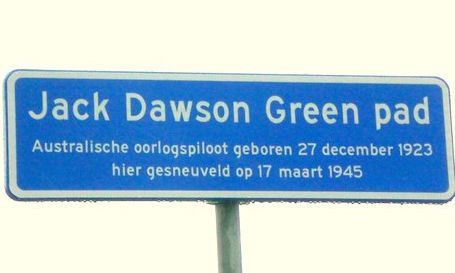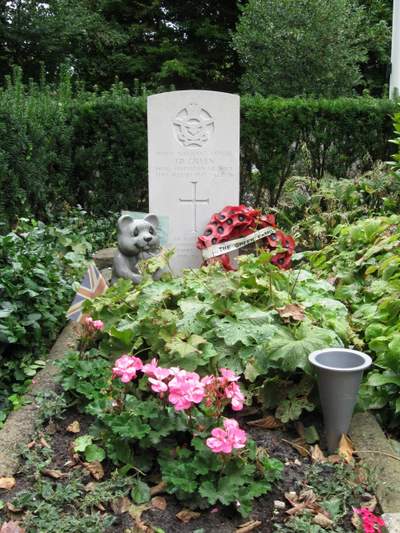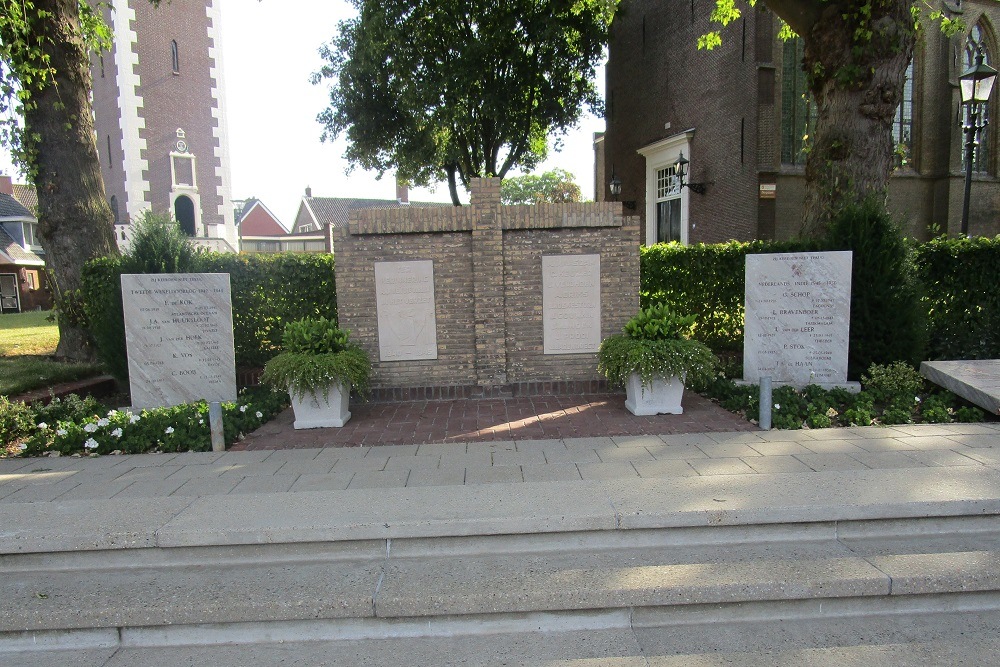Introduction
March 17, 1945. I suddenly heard the sound of aeroplanes. The German soldiers heard it as well and came outside, armed with their guns. It was a large group of small aeroplanes. Underneath the wings I saw large, coloured rings. "They are English aeroplanes," the Germans screamed. The aeroplanes flew by, but suddenly one of them returned and opened fire on the military truck driving on the road.
The story
It was Saturday March 17, 1945 at 3:45 PM. We, my older sister Jopie and I, were playing outside on the street in front of our house. It was my grandfather’s house. In early 1945, when we lived in a village named Strijen, the German occupiers had ordered us to leave our house. My grandfather’s house was vacant because the German occupiers had flooded the area surrounding the nearby Barendrechtse brug and ordered the people who lived there to leave. Nevertheless, my parents had to find a house. In the house next to my grandfather’s, German soldiers who operated the FLAK- anti-aircraft gun near the bridge were housed. My father and mother went to the Germans and asked them if they could live in my grandfather’s house. They agreed to let us live in the house although my mother had to cook for the soldiers. There was no choice so that is how we moved into my grandfather’s house.
Back to March 17, 1945. I suddenly heard the sound of aeroplanes. The German soldiers heard it as well and came outside, armed with their guns. It was a large group of small aircraft. Underneath the wings I saw large, coloured rings. "They are English planes," the Germans screamed. The aeroplanes flew by, but suddenly one of them returned and opened fire on the military truck driving on the road.
The FLAK- anti-aircraft gun at the bridge opened fire on the aeroplane, but the soldiers next to me also started shooting with their guns. My sister Jopie, who stood next to a German soldier who was shooting at the approaching aeroplane, saw the pilot look at them. Suddenly, his head fell to the side and the aeroplane above our head made a sharp turn to the left and crashed near me on the flooded farmland.
About an hour later, I was allowed to walk to the aeroplane with the soldiers to check how the pilot was doing. I was not allowed to walk further than the nearby farm. The soldiers walked further and returned after a while with a light coloured cloth with something lying in it between them. They went inside the barn of the farm and came back outside shortly after and told me that the pilot was lying in the coloured cloth (which turned out to be his parachute). They had found him dead in the cockpit of his aeroplane. He had been hit in his head by a bullet when he flew by shooting at the military truck. That was the last I saw of the pilot.
I have never been able to let go of the event and I visited the place of the crash at various times when I was older, wondering to myself who the pilot was and where he was buried. There was no grave on any of the cemeteries in the local villages. I also visited the place of the crash with our son and told him what I had seen on March 17, 1945.
It was July, 2008. My son approached me with a book in his hand. "Dad, this book has the answer you have been searching for for years," he said. I opened the book and read a report of the crash, written by Wim Wüst in his book One of our aircraft is missing about the dogfights above the Hoeksche Waard from 1940 to 1945.
In the book, I read that the pilot was the then 21-year-old Australian R.A.A.F. Spitfire pilot Warrant Officer Jack Dawson Green, buried in the public cemetery in Barendrecht. I went to the cemetery that same evening and after 63 years, I was once again standing close to the pilot I had last seen lying in his parachute. It was an emotional moment for me. I assumed that this would close a chapter in my life.
Even though I now knew who the pilot was and where he was buried, I was still unable to let go of it. I got in touch with author Hans Onderwater who lives in Barendrecht and co-writer of the book I mentioned earlier. He told me that in May 2008, Jack’s 88-year-old sister from Australia had visited the grave of her brother and that she had never spoken to an eyewitness of the crash. Dominic Hoogsteder, lieutenant colonel of the Royal Netherlands air force, also offered his help. Later on, the Oranjeverening van Heinenoord and the municipality Binnenmaas offered their assistance.
In October 2008, I sent a proposal to the town council of Binnenmaas with the request to give the nameless road where the plane had crashed the name of the pilot. In December 2008, I received confirmation that the council had granted permission to give the road the name Jack Dawson Green pad.
When Jack’s sister received the news, she expressed her wish to be present at the unveiling. The road is included in a site allocation plan for a new industrial park and in the future, it will merge with the area.
In order to retain a permanent tribute to the pilot, I tried to have a memorial placed. After I told my story, a company which produces memorials agreed to produce and place the memorial for free because of the purpose the memorial would serve. 'This pilot also died for my freedom', the young manager of the company told me. Again, I became very emotional.
A period revolving around organisation began. The 91-year-old sister of the pilot and her daughter were invited to come visit the Netherlands. The ambassador of Australia in the Netherlands expressed the desire to attend the unveiling on behalf of the Australian government. The highest Air Force attaché of the USA in the Netherlands also wanted to be present on behalf of the Allied powers. Students of the schools from the surrounding villages were also invited.
On May 3, 2010, the nameplate "Jack Dawson Green pad" was unveiled in the presence of the students and the sister of the pilot. Just a little later, close to the spot where the plane had crashed, the sister of the pilot together with the Australian ambassador unveiled a black, marble memorial. A permanent tribute to the young pilot who fought for our freedom and gave his life far from his parental home.
Additional information: The Jack Dawson Green Pad will in the future merge with the industrial park. In 2014, Anton de Man requested the town council of Binnenmaas to rename the road on which the memorial is located and change the name Buitengorzen pad to Jack Dawson Green pad. The council agreed to his request and since then the road on which the memorial is located, Jack Dawson Green pad is a permanent tribute.
Definitielijst
- FLAK
- Flieger-/Flugabwehrkanone. German anti-aircraft guns.
Information
- Article by:
- Redactie TracesOfWar.com
- Translated by:
- Sebastiaan Berends
- Feedback?
- Send it!








